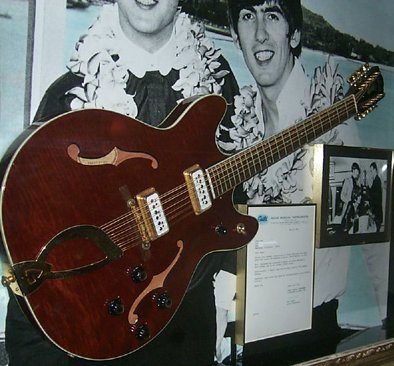
1966: Guild
Starfire XII 12-string:
While this writer and his friends milled around in the
crowd outside
New
York's Warwick Hotel on 23 August 1966, in the banquet
room inside this
one-off guitar was presented to Lennon by Mark Dronge
(son of Guild
Guitars
founder Alfred Dronge), now head of D&R HandMade
Strings.
(Read
his account of the presentation here.)
This guitar, styled like a Gibson 335, featured a
special "flamed"
maple
finish and DeArmond pickups. An
unsubstantiated report
places
it in the recording of "Getting Better." This
guitar somehow
wound
up with Tony Cox, Yoko Ono's first
husband. Cox sold the
guitar
to the Hard Rock Cafe, Honolulu, where it can be seen,
along with a
letter
of authenticity sent by Guild to Cox in March 1980.
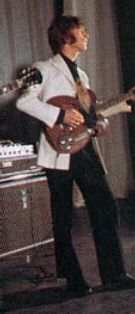 1967: 1966
Vox Kensington: This odd prototype guitar was a
gift from Vox and
shows
up in the "Hello, Goodbye" video session shots (although
not in the
finished
promos), but little else is seen of it save for a photo
of Harrison
with
it rehearsing "I Am the Walrus" during Magical
Mystery Tour.
Contrary
to other reports, there was only one of these models
created.
Mike (a.k.a. Mick) Bennett from Vox made this mahogany
hollow-body
guitar
for the Beatles; after first displaying it at a 1966
trade show
(below),
Vox took it back to the workshop for the addition of
some push buttons
for special effects, then presented it to the
band. Not long
after,
Lennon gave it to "Magic Alex" Mardas as a birthday
present, and it is
from this collection that it was auctioned at Christies
(below)in April
2004. 1967: 1966
Vox Kensington: This odd prototype guitar was a
gift from Vox and
shows
up in the "Hello, Goodbye" video session shots (although
not in the
finished
promos), but little else is seen of it save for a photo
of Harrison
with
it rehearsing "I Am the Walrus" during Magical
Mystery Tour.
Contrary
to other reports, there was only one of these models
created.
Mike (a.k.a. Mick) Bennett from Vox made this mahogany
hollow-body
guitar
for the Beatles; after first displaying it at a 1966
trade show
(below),
Vox took it back to the workshop for the addition of
some push buttons
for special effects, then presented it to the
band. Not long
after,
Lennon gave it to "Magic Alex" Mardas as a birthday
present, and it is
from this collection that it was auctioned at Christies
(below)in April
2004.
Note: This guitar
wasn't
originally
designed as part of the Vox Kensington model
line but over the
years
has come to be referred to as such. |
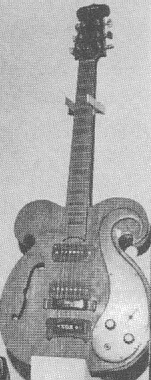
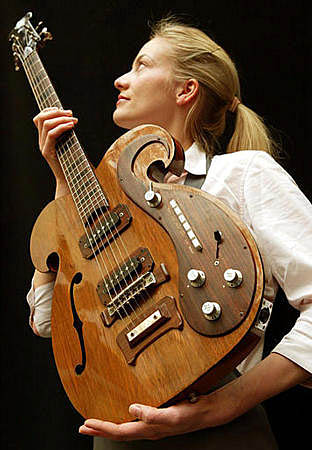
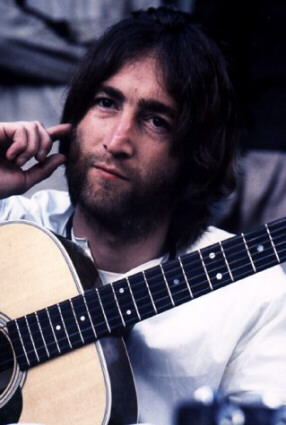 1967: 1965
Martin D-28. This dreadnought acoustic
took its place
alongside
the Gibson J-160E on Beatles albums, beginning with The
Beatles.
Lennon
brought it to India in February 1968 and composed on
it most of
his "White Album" songs. In December 1969 Lennon
took this guitar
along on a visit to Toronto, and gave it to rockabilly
guru Ronnie
Hawkins.
However, a recent inspection revealed that the guitar
Hawkins now has
is
a 1972 D-28. The Hawk says Lennon's gift
"was 'exchanged'
by someone I thought was a friend; didn't know 'til
lately . . . the
way
of the world." Attention scoundrel
houseguest: Shame
on you. Give it back.
1967: 1965
Martin D-28. This dreadnought acoustic
took its place
alongside
the Gibson J-160E on Beatles albums, beginning with The
Beatles.
Lennon
brought it to India in February 1968 and composed on
it most of
his "White Album" songs. In December 1969 Lennon
took this guitar
along on a visit to Toronto, and gave it to rockabilly
guru Ronnie
Hawkins.
However, a recent inspection revealed that the guitar
Hawkins now has
is
a 1972 D-28. The Hawk says Lennon's gift
"was 'exchanged'
by someone I thought was a friend; didn't know 'til
lately . . . the
way
of the world." Attention scoundrel
houseguest: Shame
on you. Give it back.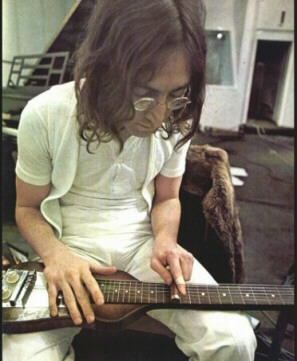 Lennon
also played other guitars the Beatles passed around,
including a Hofner
5140
Hawaiian Standard lap steel guitar (left)
he used on "For
You Blue" and a Fender Bass VI, a 6-string bass
(right) he and Harrison
used on The Beatles and Let It
Be. It featured
three pickups and a vibrato, and he used it for some
rather low-end
chords
on "Dig It."
Lennon
also played other guitars the Beatles passed around,
including a Hofner
5140
Hawaiian Standard lap steel guitar (left)
he used on "For
You Blue" and a Fender Bass VI, a 6-string bass
(right) he and Harrison
used on The Beatles and Let It
Be. It featured
three pickups and a vibrato, and he used it for some
rather low-end
chords
on "Dig It." 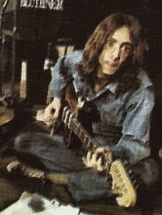 He
also
briefly owned a Vox "guitar organ" that in time was
auctioned
off.
And during the '65 tour, Lennon bought a Spanish
guitar in, of
all
places, Spain, which may have been used on Rubber
Soul.
Also,
as did Harrison, Lennon received a Danelectro Coral
electric
sitar in 1967; it's never heard on any recording.
He
also
briefly owned a Vox "guitar organ" that in time was
auctioned
off.
And during the '65 tour, Lennon bought a Spanish
guitar in, of
all
places, Spain, which may have been used on Rubber
Soul.
Also,
as did Harrison, Lennon received a Danelectro Coral
electric
sitar in 1967; it's never heard on any recording.